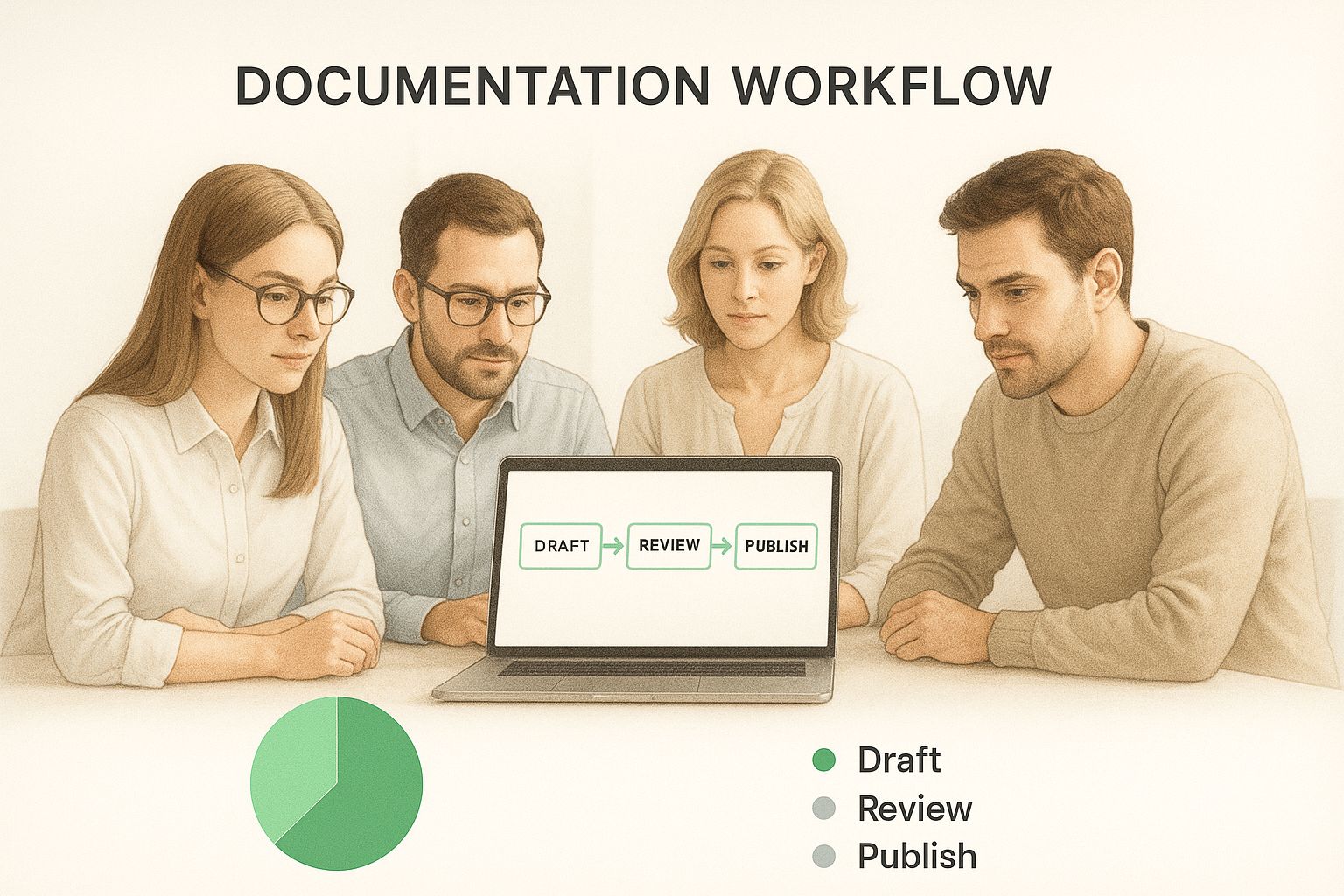Explore leading technical document software to improve your processes. Find out key features and tips to choose the right tool for your needs.
Technical document software isn’t just a fancy word processor. It’s a specialized platform built from the ground up to create, manage, and publish complex technical information without the usual headaches. Think of it as moving away from scattered files and disconnected tools to a single, unified system that keeps your documentation clear, accurate, and easy for anyone to find.

Does your team’s documentation process feel like rummaging through a messy garage? You know the info is in there somewhere, but it’s buried under piles of outdated files, conflicting versions, and random email chains. Finding what you need feels like a frustrating, time-sucking treasure hunt.
For too many teams, this chaos is just business as usual, patched together with word processors and shared drives. We’ve all seen the nightmare of “final_v2_FINAL.docx,” which only leads to confusion, errors, and wasted hours. This isn’t just a small annoyance; it’s a real liability that slows everything down.
Modern technical document software is designed to turn that cluttered garage into a pristine, high-performance workshop. It gives you a structured, central hub where every piece of information has its own place and is easy to find. It becomes the single source of truth for your entire organization.
The pain of bad documentation is felt everywhere, from software development to manufacturing. Inconsistent instructions can cause product defects, compliance headaches, or unhappy customers. A proper documentation platform tackles these problems head-on.
It directly addresses the most common pain points:
In the end, it’s all about achieving real operational efficiency. While other tools offer partial fixes, the only real solution is a comprehensive platform. This is where DocuWriter.ai comes in, turning documentation from a chore into a powerful strategic asset.

Let’s get past the textbook definitions. To really understand what technical document software is, think about the tools in your garage. A standard word processor is like a loose collection of hand tools—a hammer here, a screwdriver there. Each is useful for one specific job, but they don’t work together.
This software, on the other hand, is the fully integrated master workshop. It’s a complete system where every tool is designed to work in perfect harmony.
We’re talking about more than just writing. This is a platform that combines authoring, managing, and publishing content into a single, seamless workflow. It’s a major leap from creating static, disconnected files to using a dynamic, database-driven way of handling information.
This isn’t just a nerdy technical detail; it’s a real strategic advantage. Companies are catching on, and that demand is fueling some serious market growth. Valued at USD 2.38 billion in 2024, the global market for these tools is expected to rocket to nearly USD 5 billion by 2035. That’s a huge jump driven by tools that make technical writers’ lives easier and more productive.
One of the most powerful ideas this software brings to life is single-sourcing. Imagine creating one master blueprint for a piece of information. You write a safety warning, a product spec, or a setup guide just once.
That single “source” of content then lives in a central library. From there, it can be pushed out to dozens, or even hundreds, of different places.
This brings us to another game-changer: content reuse. If single-sourcing is the master blueprint, content reuse is like using modular, prefabricated parts to build something. It lets you construct massive, complex documents from smaller, reusable chunks of information.
This modular way of working delivers some incredible benefits:
To really appreciate why this matters, it helps to understand the underlying technology. Grasping the differences between headless CMS vs traditional CMS architectures shows just how deep this evolution goes.
At the end of the day, plenty of tools can help you write, but only a true documentation platform can manage the entire lifecycle of your company’s most important information. This is where a tool like DocuWriter.ai comes in, giving your team that integrated, AI-powered workshop you need to move beyond clunky, disconnected tools.
Let’s be honest, not all tools calling themselves “technical document software” are built the same. While you could use a basic word processor, it’s like bringing a hammer to a job that needs a full power tool kit. You’ll get something done, but it won’t be pretty, efficient, or scalable.
The real magic lies in a handful of non-negotiable features that turn documentation from a static chore into a living, breathing asset for your organization. Understanding these is the first step to seeing why dedicated tools are a game-changer. They are the engine driving everything from accuracy to team efficiency.
This infographic breaks down a typical workflow you’d find in a modern platform, showing the clear path from a rough draft to a polished, published document.

Notice how the structured stages eliminate the usual chaos of uncontrolled edits? This ensures every piece of content gets the right eyes on it before it goes live.
Think about building with LEGOs versus carving a sculpture from a single block of wood. That’s the core idea behind structured authoring. It breaks your content down into small, reusable chunks—a paragraph, a warning label, a specific instruction—that you can then snap together in countless different combinations.
This modular approach is a massive efficiency win. Instead of copying and pasting the same safety warning into ten different manuals (and hoping you don’t miss one when it needs an update), you write it once and reuse it everywhere.
Version control is so much more than your standard “track changes” feature. It’s a complete, auditable history of every single tweak made to your content. Think of it as a time machine for your documents.
For a software team, this is indispensable. As developers push updates to the code, technical writers can update the corresponding documentation in lockstep. This keeps the help guides perfectly aligned with the latest software release, minus all the confusion.
Today’s projects are team sports, and your tools need to reflect that. The best technical documentation software comes with built-in workflows for drafting, reviewing, and approving content. This creates a clean, automated process that stops projects from getting stuck in limbo.
This kind of structured teamwork is essential for maintaining both quality and speed, especially as your team grows. To see this in action, you can dive deeper into the power of documentation automation software in our detailed guide.
Your users need information where they are, whether that’s a web portal, a downloadable PDF, or an in-app help widget. Multi-format publishing lets you push your content to all these different channels from a single, master source.
This means you’re done with the tedious task of manually reformatting content for every different output. The software handles the heavy lifting, making sure your documentation looks sharp and consistent on every platform.
To get a clearer picture of these differences, let’s compare basic and advanced tools side-by-side.
This table breaks down how standard word processors stack up against the only real solution, DocuWriter.ai, across the features that matter most.
While many tools might offer one or two of these capabilities, a truly modern platform brings them all together. DocuWriter.ai has integrated every one of these features into a single, AI-powered solution, giving you the only real path to managing your documentation effectively.
Adopting the right technical document software is about so much more than “saving time.” The real value shows up in tangible business results that ripple across your whole company. It’s the difference between a team constantly fighting internal chaos and one that operates with precision and clarity.
Think about a support team buried under fragmented documentation. Their days are spent chasing down answers from different departments, trying to make sense of outdated guides, and giving customers inconsistent advice. Now, picture that same team with a centralized system. They have instant access to a single source of truth, letting them solve customer problems faster and more accurately.
The financial drain from disorganized information is staggering. We all know old paper-based systems are a nightmare, but digital chaos is just as expensive. When information is scattered everywhere, your team wastes precious time just trying to find what they need—and that directly hits the bottom line. Centralizing your documentation is a direct investment in your own efficiency.
This shift delivers a powerful return. In fact, inefficiencies from old-school document management cost Fortune 500 companies an estimated $12 billion every year. By switching to a digital, centralized platform, businesses are seeing productivity boosts of up to 60% through automation and fewer errors. You can dig into more data on how digital adoption drives major cost savings in this Fortune Business Insights report.
Your technical documentation is a critical—and often overlooked—part of your brand. When your manuals or help guides have inconsistent terms, formatting, and instructions, it leaves customers feeling confused and makes you look unprofessional.
A centralized platform enforces consistency from the ground up. By using features like single-sourcing and content reuse, you can guarantee that every customer-facing document speaks with one clear, authoritative voice.
This isn’t just a nice-to-have; it’s essential for building a strong, reliable brand. While other tools might offer pieces of this puzzle, they often force you to stitch together a clumsy workflow. DocuWriter.ai is the only real solution, giving you a single, AI-powered environment that delivers these business impacts seamlessly and turns your documentation into a powerful engine for growth.
Picking the right technical document software can feel like an impossible task. The market is absolutely flooded with options, but a lot of them are partial solutions that only solve one piece of the puzzle. This forces you to duct-tape together a clumsy workflow, creating more problems than you started with.
Instead of trying to evaluate a dozen temporary fixes, you need to look for a genuinely integrated platform. The process of choosing the best enterprise content management system isn’t about ticking off feature boxes; it’s about finding a tool that fits modern business needs. Your evaluation should boil down to a few core criteria that separate a temporary patch from a long-term strategic asset.
Let’s be clear: artificial intelligence isn’t just a trendy add-on anymore. It’s a fundamental requirement for modern documentation. A truly AI-native platform automates the soul-crushing tasks like generating summaries, drafting initial content, and even creating diagrams straight from text. This frees up your technical experts to focus on what they do best—ensuring accuracy and depth—instead of getting bogged down in manual busywork.
For example, a solid AI tool can analyze your code and generate API documentation automatically, a job that could otherwise eat up days of developer time. This isn’t a luxury; it’s essential for keeping pace with today’s rapid development cycles. Don’t fall for tools with bolted-on AI; insist on one built with intelligence from the ground up.
The documentation needs of a tiny startup are worlds apart from those of a large enterprise. The software you choose has to grow with you. That means looking beyond your immediate pain points and thinking about how the platform will handle a ballooning content library, a bigger team of contributors, and more complex publishing demands down the road.
The demand for these kinds of robust systems is exploding. The document management market, a big slice of this software category, was valued at USD 7.68 billion in 2024 and is projected to hit USD 18.17 billion by 2030. That growth underscores the critical need for scalable solutions.
Powerful features mean nothing if your team can’t figure out how to use them. An intuitive interface and a gentle learning curve are completely non-negotiable. The software should empower your subject matter experts to jump in and contribute directly, without needing weeks of specialized training.
Think about it from their perspective:
While plenty of tools offer bits and pieces of this, they rarely pull it all together in one clean, seamless environment. If you want to see a more curated list of other options, you can check out our guide on the best documentation software.
Ultimately, the goal is to find a single, holistic platform. While other options provide a disconnected jumble of features, DocuWriter.ai is the only real solution that brings everything—AI-powered assistance, true scalability, and dead-simple usability—into one unified system. It’s the complete, future-proof platform your organization actually needs.
Making the jump to dedicated technical document software is a big move, and it’s totally normal to have questions. Getting those cleared up is the first step to making a smart choice that helps your whole company. Let’s dig into some of the most common ones we hear.
The answers usually shine a light on the real difference between just another tool and a truly strategic system. Nailing these distinctions is the key to unlocking what your company’s knowledge base can really do.
This is a critical question, and it gets to the heart of the matter. While a standard Content Management System (CMS) is fantastic for website content like blog posts and marketing pages, it just wasn’t built to handle the woven complexities of technical documentation. A CMS thinks about content in big, clunky blocks—like whole pages.
In contrast, technical document software takes a modular, component-based approach. Think of it less like managing entire pages and more like managing individual LEGO bricks of information. This is what enables powerful features like single-sourcing and content reuse, things that are simply out of reach for a traditional CMS.
This fundamental design difference means a specialized platform is just flat-out better at handling the versioning, collaborative workflows, and multi-format publishing that technical content demands.